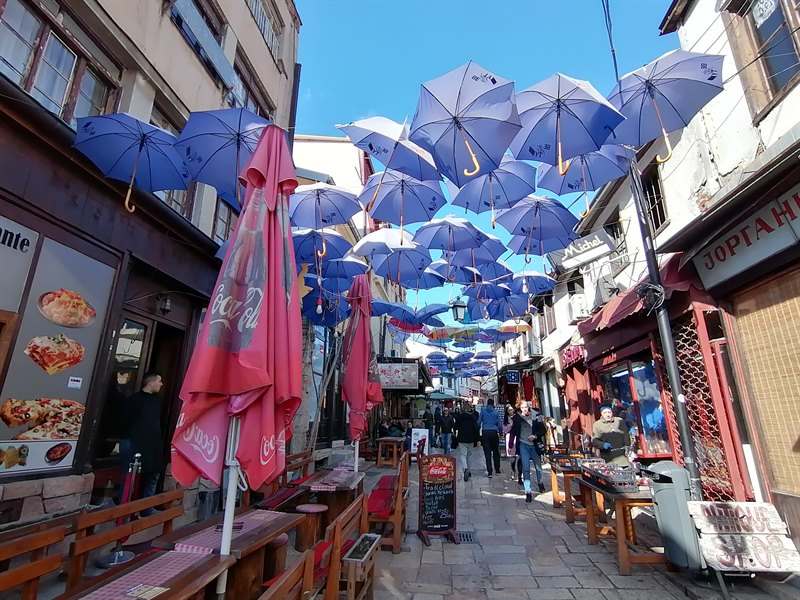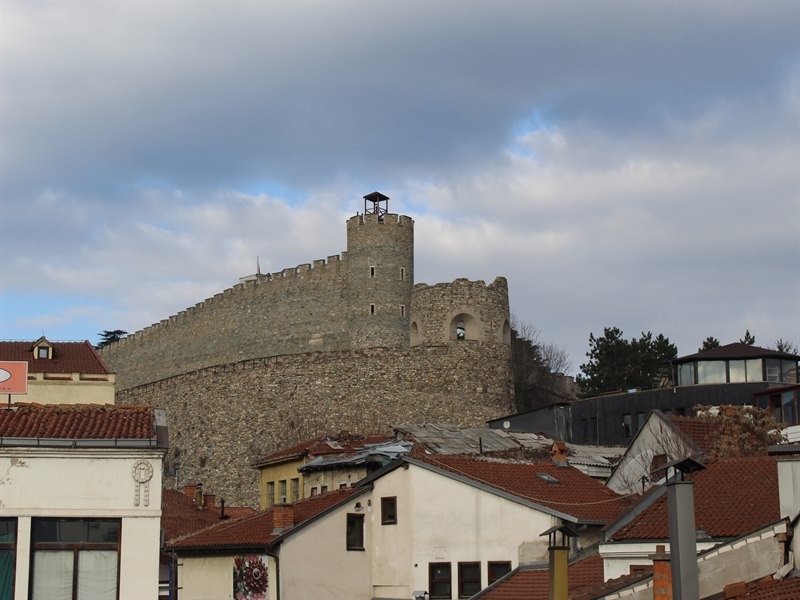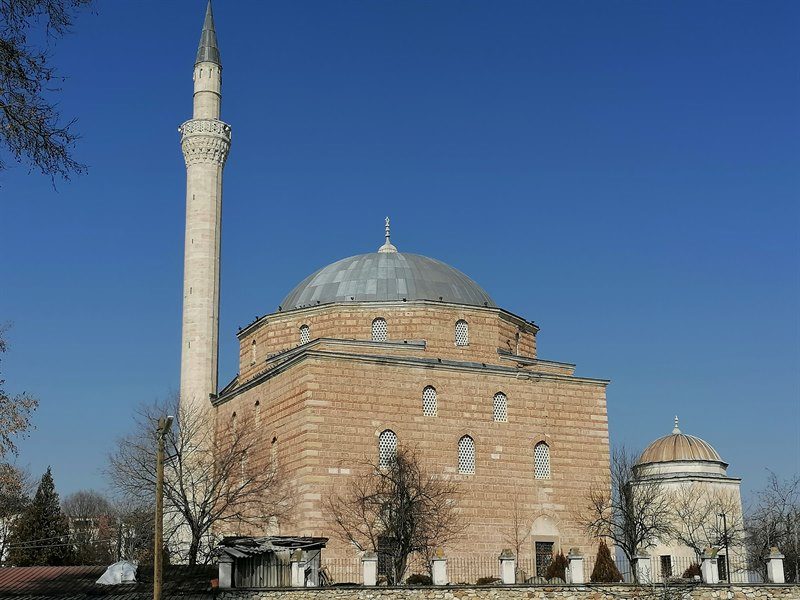
As a Thessalonikian and Macedonian, my visit to Skopje was a challenge. So I tried to overcome the challenges and propaganda of the neighboring country and see this city with a clear tourist orientation. To a great extent I have succeeded and ask you to do the same!
A few words about the city
Skopje is the capital and largest city of North Macedonia, with a population of 467,257 inhabitants. The city is built at an altitude of 262 m. in the center of the Balkan Peninsula, facing east-west, along the Vardar River (Axios). Skopje was particularly developed during the years of the Ottoman Empire, being known as "Uskiup", while it remained under Ottoman rule for over 500 years and was the capital of the homonymous Sanja. In recent decades the city has filled statues, monuments, heroes and generally various buildings with reference to the Macedonian race and the heroes of the time, in an effort to develop the National mind. So I have chosen for you, what I consider to be worthy of attention for someone who is visiting the city for the first time.
Ploštad Makedonija
Undoubtedly the square of Macedonia (Ploštad Makedonija) is not only the most central point of the city, but also of the whole country. It is apparently the largest of Northern Macedonia with a total area of 18,500 sq. M. and plays a very important role for the locals after the country's independence was declared there.
At its center there is an impressive statue called "The Warrior on Horse" (Voin na konj) and apparently refers to Alexander the Great on Bucephalus. This statue was erected by the Municipality of Centar and was unveiled on September 8, 2011, the day of the 20th anniversary of independence from Yugoslavia. Around you will find many more monuments and statues, most notably those of Goce Delcev, Dame Gruev, Justinian and Cyril and Methodius.
Finally, it is worth visiting the square just next, the Philip II Makedonski square to see the enormous statue of Alexander's father, the church of St. Demetrius (Pravoslavna crkva Sveti Dimitrija) and the soldier's monument (Spomenik na voinot).
The Bridges
The city of Skopje, as I mentioned above, is crossed by the Axios River, or as the locals call it Vardar. To pass from one side to the other, it is enough to cross one of the dozens of bridges that exist along it. However, the three most beautiful are the stone bridge (Kamen most), the eye bridge (most OCO) and the art bridge (most na umetnosta).
The first is the oldest and at the same time the most famous of the city. It is 214 meters long and 6 meters wide and dates back to the 15th century. Of course, over the centuries, it "suffered" a lot, especially in the earthquake of 1555, from which the four columns were severely damaged, but after conservative interventions, it still stands imperious, uniting the center of Skopje with the Old City. Interesting is the fact that in 1944 explosives were placed on the bridge by the Germans without causing any damage. The reason they were not detonated, remains still to this day unexplored.
The second in order, the Eye Bridge or as its official name is "the bridge of the cultures of Macedonia", is characterized by many as the most "kitsch" of the city. It leads to the Archaeological Museum of Skopje and is decorated with dozens of statues on both sides.
Finally, it's worth crossing the bridge of art, which we would say is identical to the one above. And it is decorated with 27 statues (13 right-13 left) and one in its center, while it was created in 2014 as part of the city's reconstruction. This bridge leads to an impressive circular building, which is the Primary Public Prosecutor's Office of the country.
Memorijalna kuḱa Majka Tereza
The comparative memorial house (Memorijalna kuḱa Majka Tereza) is dedicated to the humanist and Nobel Peace Prize winner, Mother Teresa. Mother Teresa was born in Skopje and lived in the country from 1910 to 1928. The building was built on the popular shopping street "Macedonia", on the site of the Roman Catholic Church of the Sacred Heart of Jesus, where Mother Teresa was baptized. Inside, one can see photos of the country from the early 20th century, when it was still part of the Ottoman Empire, with furniture, clothes and, of course, many of Mother Teresa's own personal belongings. The exhibition aims to follow her life from her birth in the city of Skopje until her death as a missionary. Admission is free.
Right next to it, there is an impressive Christian Orthodox church, dedicated to Constantine and Helen (Pravoslavna crkva Konstantin i Elena), dating from 1926. Unfortunately, it isn’t open at this time, as it is under maintenance. Almost glued to the church, there is another attraction, the feudal Tower (Feudalna kula). It was part of the fortification of the city, but neither the time it was built nor its builder are known. Most likely, it is a feudal tower of some Turkish Bay. And here you will not be able to enter, because it is in the yard of the preserved church.
Stara čaršija
The Old Bazaar (Stara čaršija) is definitely the heart and soul of Skopje. It was founded seven centuries ago and today it is one of the most famous landmarks of the city, being the largest Bazaar in the Balkans! The narrow cobbled streets combine the old with the modern, depicting the whole spectrum of the city's history. Countless shops selling local products, tea shops that even serve tea in a small typical glass on a metal tray, kebab restaurants and shops with traditional sweets, are just some of what you will find in this Muslim neighborhood.

Tvrdina Kale
The Fortress of Skopje, commonly called Kale Fortress (Tvrdina Kale), or simply Kale (from the Turkish word kale, which means "fortress"), is perhaps the most historical attraction of Skopje and is located at the highest point of the city, overlooking the Vardar River. The first building at this point is believed to have been constructed in the 6th century A.D. however the fortress was reconstructed in the Byzantine period during the reign of Justinian I, while it was extended in the 10th and 11th centuries A.D.. It was then occupied by the Bulgarians, Ottomans and Austo-Hungarians, and was partially destroyed again by an earthquake in 1963. Today after maintenance remains the pride of the city, but it is not open to the public. But the view from that point will reimburse you.

Porta Macedonia
The Gate of Macedonia (Porta Macedonia) is a triumphal arch, built in 2012 and is a tribute to the country's 20 years of independence. It was designed by Valentina Stefanovska, the same sculptor who created the statue of Alexander the Great, and is decorated with relief scenes from the history of Macedonia! The arch is 21 meters high and cost 4.4 m euros, which was a major criticism of the government. Finally, the arch also includes interiors, one of which functions as a state-owned souvenir shop, as well as elevators and stairs that provide public access to the roof, which is allegedly intended as a wedding venue!
Mustafaamija Mustafa Paša
The Mosque of Pasha Mustafa (Mustafaamija Mustafa Paša) was built in 1492, on the foundations of a medieval church, as evidenced by the marble slab above the front entrance. This building is a typical representative of the early architecture of Constantinople. Its base is square and covered with a dome, the diameter of which is 16.3 m., while the 47m high minaret is raised in the northern part of the mosque, being built of crushed limestone. Inside there is a prayer room, in the south-eastern part of which there is a mihrab, from which the Koran is read. Unlike other buildings in the city, the mosque was not badly damaged by the 1963 earthquake. However, after the earthquake some reconstructive activities were carried out, with the last one completed in 2011. Finally, in this place there is a funerary monument (turbe), in which Mustafa himself and his daughter are buried.

Mileniumski krst
The Millennium Cross (Mileniumski krst) is a symbol for the country, but also for the whole of Christianity. It is located at the top of Mount Vodno and is 66 meters high, being one of the largest crosses in the world! Its construction began in 2002 and was completed in 2008, with the aim of serving as a 2,000-year-old Christian monument. This location was chosen, on the one hand, to be visible from everywhere but on the other hand because this place was known from the Ottoman period as "Krstovar", which means "Place of the Cross", as there was a smaller cross. In the evening the cross is illuminated and becomes even more impressive, while there are thoughts of building a monastery right next door. To reach it you can use either the cable car, except on Mondays when it is not working or a bus that leaves you in the middle of the route.
The museums
There are two museums worth visiting in Skopje, the Archaeological Museum (Arheološki muzej na Makedonija) and the Museum of the Macedonian Struggle (Muzej na makedonska borba).
The first is one of the most beautiful and characteristic buildings of the city and strongly resembles an archaeological Greek temple. And this building is recently constructed, only in 2014, and hosts finds from different parts of the country. On the three floors, you will find Byzantine treasures, advanced 3D reconstructions of prehistoric skull faces and a Phoenician royal necropolis. Admission costs 120 dinars, or about 2e.
The second is essentially facing the Archaeological Museum and in the evening it is illuminated with the colors of the country's flag (red and yellow). This particular museum is unsuitable for children, since it is dark and very realistically depicts the hardships of the heroes of the country. Typically the walls are black and the lighting very low, while surrounded by gruesome oil paintings, depicting scenes of battle and betrayal, most typical of a dead rebel hanging from the rafters. And here the entrance costs 120 dinars, that is, about 2e.
How to go
There is no direct flight from Thessaloniki to Skopje, so if you want to go to the city by air, you have to make at least one stop. The best solution is to go with Ryanair to Budapest and from there with Wizzair to Skopje, with a total cost of 151e round trip. Of course, the distance by road is about 2.5 hours, and the road is very good, so the appropriate solution is to go by your own means of transport. You will not need a vignette, as there are tolls all the way (total 7.5e).
Where to stay
Skopje is not a tourist resort and combined with the fact that they do not use Euro but Dinar, they make the issue of accommodation "a piece of cake". The prices are extremely low, since you can easily find a room in a five-star hotel with about 50e!! My suggestion is Hotel De KOKA, a 3 star hotel with private parking, elegant rooms fully equipped with plasma TV, mini fridge, hot tub and anything else you may need.
How to move
Skopje is a small town whose main tourist interest is concentrated in its center, which is easily walked on foot. If you need public transport, you should use the local red double-decker buses, which are the only ones in the city. Tickets cost 30 dinars, that is about 50 cents and you get them from the driver.
What to eat
The cuisine of the region is influenced by the Balkans, the Mediterranean and the Middle East. The relatively warm climate of the country provides excellent growing conditions for a variety of vegetables, herbs and fruits, while it has a wide variety of dairy products, wines and local alcoholic beverages such as raki. The country's national dish is called Tavče gravče, which contains beans and is served in a clay pot, while the national drink is mastic. A good restaurant that balances the traditional and the modern is Kolektiv, where you can try all the local dishes, as well as burgers, pizza and other handmade fast food. I also suggest trying kebabs and local sweets combined with tea at the old bazaar, as well as have a coffee or drink overlooking the river, on one of the ships stranded there. The first in the series is called Senigallia and also operates as a hotel.
Useful information

In Northern Macedonia we travel with Passport or a new type Police ID, where the data is written in Latin characters.
In Skopje, the language used is Slavo-Macedonian, while most also speak Albanian, Russian, Serbian, Romanian and Bosnian, depending on their region and origin. Younger people also know English, while everyone is willing to help if they know.
The currency of the country is the Dinar of Northern Macedonia (MKD) and its exchange rate at the moment is 1 € = 61.36 dinars.
Skopje is one hour behind Greece (GMT +2).
Convert your money either to the dozens of banks that exist in the city, or to the exchange offices, which indicate the exchange rates, since they take very little commission. In many shops they also accept euros.
The transfer to and from Skopje Airport is simple, as there are bus routes that will take you to the city center in half an hour with 180 dinars (about 3e).
The Greek Embassy in Skopje is located at 6 Borka Taleski Street and its phone number is +3892 3219260.
Skopje and the whole country in general, have a continental sub-Mediterranean climate, which means cold winters and hot summers. Since it is not wet from the sea and it is not famous for winter sports, it would be good to avoid these periods. As an area with a lot of green, the ideal time is spring when everything will be in bloom or even in autumn.
Suggested excursions → Ohrid, Bitola, Pristina

If this article seemed interesting or contributed to your quality information, then you can like my facebook page: o_thessalonikios or follow me on instagram!
Mouzakidis Pantelis









